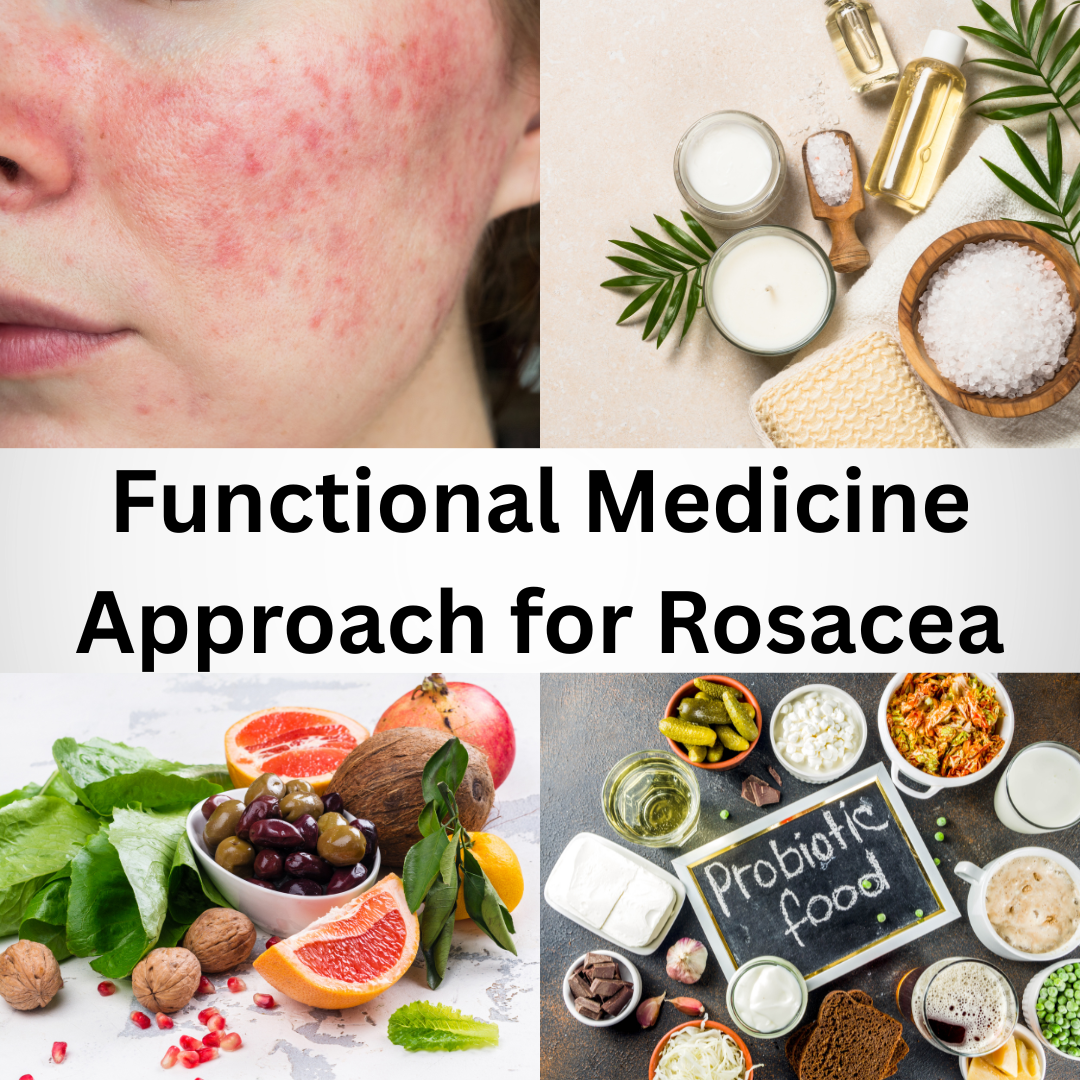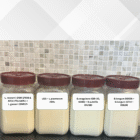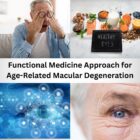Functional Medicine Approach for Rosacea
Rosacea affects over 415 million people worldwide, leading to persistent redness, bumps, and skin sensitivity that often impact daily life. Functional medicine offers a different path, root-cause resolution through systems biology and personalised care. Research reveals a powerful link between gut health, immune regulation, and skin inflammation. By healing the gut and rebalancing the immune system, it becomes possible to calm the skin from within and achieve lasting, meaningful improvements in rosacea.
What is Rosacea?
Rosacea is a chronic inflammatory skin disorder that triggers redness, visible blood vessels, bumps, and irritation, most often on the face. It typically strikes adults between 30 and 50 years old, although it sometimes appears earlier. Rosacea often cycles through periods of flare-ups and remission, making it unpredictable and frustrating. Genetics, gut health, immune imbalance, and environmental triggers all drive its development. Furthermore, without early support, rosacea progresses and worsens over time. Common triggers include spicy foods, alcohol, temperature changes, and emotional stress. Moreover, far from being just a cosmetic issue, rosacea reflects deeper internal imbalances that demand a root-cause approach.
Functional Medicine Framework: Understanding Rosacea as a Systems Imbalance
Functional medicine views rosacea as a reflection of deeper systems imbalance rather than an isolated skin condition. Clinically, rosacea presents with persistent erythema, visible telangiectasia, papules, pustules, flushing, and sometimes ocular inflammation. Moreover, subtypes, including erythematotelangiectatic, papulopustular, phymatous, and ocular rosacea, often overlap, creating complex and dynamic presentations. Each symptom signals underlying dysfunctions, whether vascular, immune, microbial, or hormonal, that require personalised attention. Hence, addressing these patterns through a systems biology lens unlocks better outcomes than symptom-focused treatment alone.
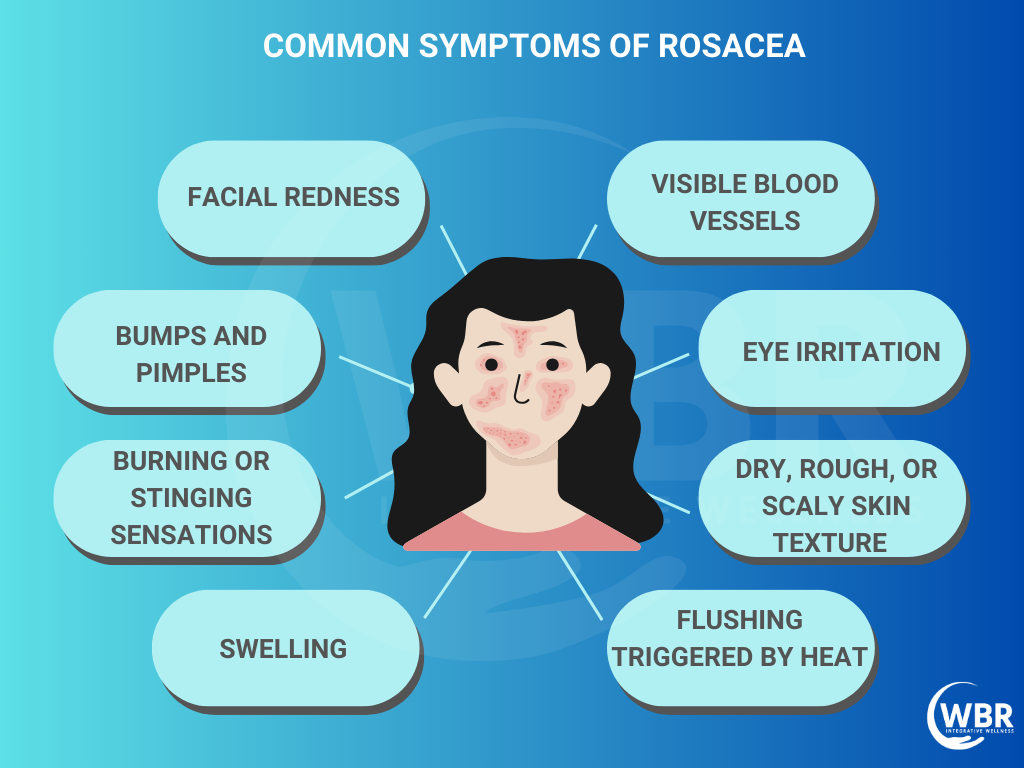
The Systems Biology Lens: Causes of Rosacea
Rosacea rarely stems from a single cause. Instead, it reflects imbalances across multiple interconnected body systems. Functional medicine organizes these imbalances into seven key functional systems, offering a roadmap for deeper healing.
Gut and Digestion: Poor digestion, dysbiosis, SIBO, and gut permeability often trigger systemic inflammation that surfaces through the skin.
Immune and Inflammation: Chronic, low-grade immune activation drives redness, swelling, and sensitivity in rosacea.
Detoxification: A sluggish detox system allows toxins and metabolic waste to build up, burdening the skin and immune system.
Hormonal Balance: Shifts in estrogen, androgens, cortisol, and thyroid hormones influence skin vascularity, oil production, and inflammatory tone.
Neurovascular Regulation: Nerve hypersensitivity and blood vessel instability contribute to flushing, stinging, and rosacea flares.
Mental/Emotional Health: Stress, trauma, and anxiety amplify inflammatory pathways, worsen gut dysfunction, and heighten symptom severity.
Oxidative Stress/Mitochondrial Function: Free radical damage and mitochondrial dysfunction impair cellular repair and resilience, fueling chronic inflammation and skin aging.
Core Root Causes Driving Rosacea
- Gut Integrity + Immune Dysregulation
Hypochlorhydria, SIBO, H. pylori, and leaky gut drive immune activation and systemic inflammation in rosacea. Moreover, low sIgA, food sensitivities, and EPI worsen malabsorption and tolerance. Addressing gut health through HCl support, pathogen clearance, and intestinal healing forms the foundation for lasting skin recovery. - Skin Barrier Dysfunction + Microbiome Disruption
Compromised skin barriers from TEWL, harsh products, and microbiome imbalance worsen rosacea flares. Repair strategies include using ceramides, niacinamide, and topical probiotics while avoiding essential oils and alcohol-based products. Furthermore, gentle, microbiome-friendly skincare restores resilience and protects against environmental and microbial triggers. - Neurovascular Sensitivity & Histamine Overload
Heat, spicy food, alcohol, and emotional stress heighten neurovascular reactivity in rosacea. Moreover, histamine intolerance, mast cell activation, and vagus nerve dysfunction fuel inflammatory cascades. Thus, supporting nervous system health, stress resilience, and histamine balance offers critical leverage in calming persistent flushing and sensitivity.
Therapeutic Strategy, Phase-by-Phase
Rosacea recovery requires a structured, phased approach rooted in restoring gut-skin balance, calming immune reactivity, and rebuilding resilience. Each stage lays the groundwork for the next, allowing the body to heal deeply and sustainably. Here’s how the process unfolds:
Phase 1: The Reset phase (4–6 Weeks)
- Elimination diet: remove alcohol, spicy/hot foods, histamines, and sugar.
- Gut repair support: glutamine, zinc carnosine, and targeted probiotics.
- Barrier-focused skincare: niacinamide, ceramides, avoid harsh products.
- Prioritize stress reduction and optimize sleep quality.
Phase 2: The Rebuild Phase (6–12 Weeks)
- Rebalance gut and skin microbiomes through continued support.
- Add immune modulators: omega-3 fatty acids, retinol, and vitamin D.
- Introduce digestive aids: enzymes, bile salts, and essential minerals.
- Layer in botanical topicals and low-intensity red light therapy.
Phase 3: The Reintroduce + Maintain Phrase
- Gradually reintroduce foods with symptom tracking and pulse testing.
- Integrate mind-body techniques: mindfulness, EFT, vagus nerve exercises.
- Establish a long-term topical regimen with daily sun protection.
- Align lifestyle with healing: minimise toxins, support sleep, and nurture emotional well-being.
Skin Care That Supports Healing
Rosacea-prone skin thrives on simplicity, hydration, and barrier protection. Thoughtful daily care strengthens resilience and reduces flare-ups over time.
Daily Skincare Do’s
- Choose soap-free, pH-balanced cleansers.
- Use niacinamide and ceramide-rich moisturisers to rebuild the skin barrier.
- Opt for thermal spring water-based products for soothing care.
Topicals with Therapeutic Potential
- Azelaic acid: reduces inflammation and bacterial overgrowth.
- Sulfur/sodium sulfacetamide: helpful for papulopustular subtypes.
- Topical probiotics: L. reuteri, L. plantarum, and Nitrosomonas eutropha promote microbiome balance.
Ingredients to Avoid
- Essential oils, chemical peels, alcohol-based toners, and harsh exfoliants that strip and irritate the skin.
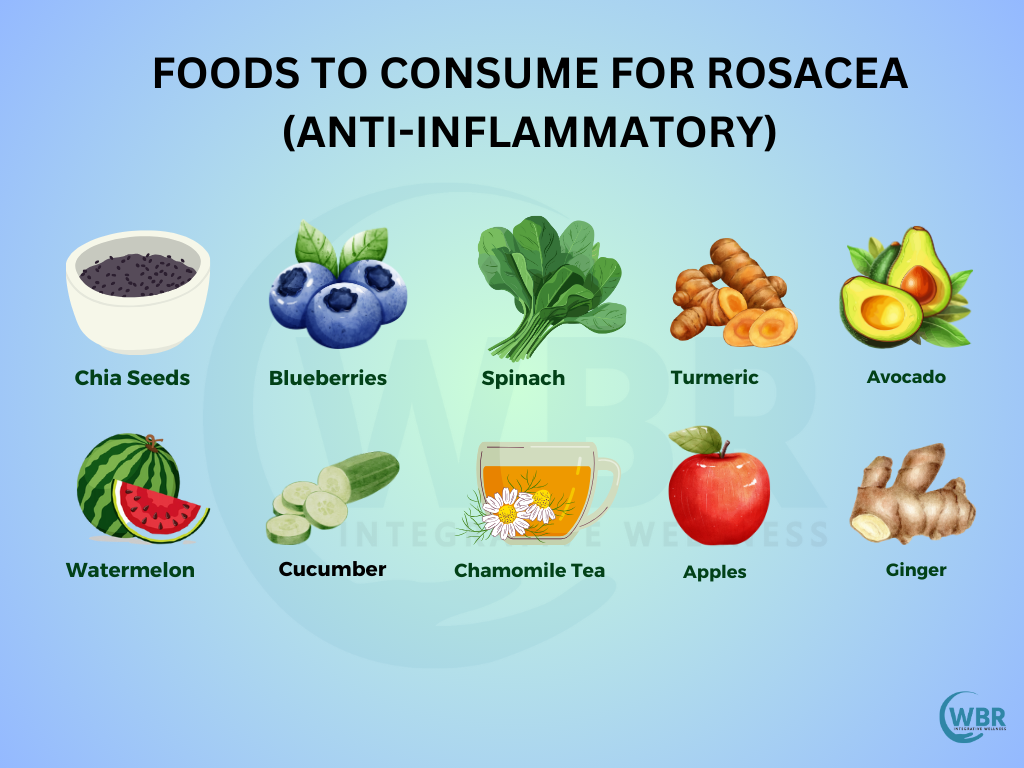
Key Probiotic Strains for Rosacea
Probiotics play a critical role in restoring balance to the gut-skin axis and supporting immune modulation, both of which are key factors in managing rosacea. The following strains have shown promising benefits for reducing inflammation, improving skin hydration, and promoting overall skin health. Below is a breakdown of the strains that may help improve rosacea symptoms.
- (DSM 17938, ATCC PTA 6475) Lactobacillus reuteri
- Immune Tolerance: Increases regulatory T cells (Tregs), which help promote immune tolerance, reducing inflammatory responses.
- Skin Barrier: Enhances the skin’s natural barrier function, reducing trans-epidermal water loss (TEWL) and improving overall hydration.
- Reduces Redness: Proven to reduce redness by decreasing systemic inflammation, thus helping alleviate rosacea flare-ups.
- Lactobacillus plantarum (299v, WCFS1)
- Gut Barrier Protection: Strengthens the gut barrier by enhancing tight junctions, reducing intestinal permeability (leaky gut), which is often linked to rosacea.
- Anti-inflammatory: Decreases the production of pro-inflammatory cytokines (IL-6 and TNF-alpha), reducing systemic inflammation.
- Antioxidant Effects: It acts as an antioxidant, which helps soothe sensitive, reactive skin that is prone to inflammation.
- Lactobacillus rhamnosus (GG, GR-1)
- Histamine Reduction: Lowers histamine levels, helping reduce flares triggered by histamine-rich foods that often worsen rosacea.
- Gut Health & Immune Support: Supports gut epithelial integrity, modulating immune responses and reducing inflammation.
- Topical Benefits: Also used in topical probiotics for its anti-inflammatory properties that help calm rosacea symptoms.
- Bifidobacterium lactis (HN019, Bl-04)
- Mucosal Immunity: Strengthens mucosal immunity by stimulating secretory IgA (sIgA), which helps protect against gut pathogens and inflammation.
- Gut Integrity: Reduces gut permeability, which helps minimize systemic inflammation that may trigger rosacea.
- Immune Response Balance: Helps balance Th1/Th2 immune responses, which can be dysregulated in rosacea.
- Bifidobacterium longum (BB536, NCC2705)
- Pro-inflammatory Cytokines: Reduces pro-inflammatory cytokines like TNF-alpha and IL-1β, helping to decrease inflammation in the skin.
- Stress Reduction: May reduce stress-induced flares through the gut-brain-skin axis, which plays a significant role in rosacea flare-ups.
- Mast Cell Regulation: Helps stabilize mast cells, which are key in histamine intolerance—a common issue in rosacea.
- Saccharomyces boulardii CNCM-i745 strain
- Anti-inflammatory: A beneficial yeast that provides anti-inflammatory benefits and is safe for individuals with Small Intestinal Bacterial Overgrowth (SIBO), often seen in rosacea patients.
- Gut Barrier Repair: Boosts secretory IgA, which supports the repair of the gut barrier and overall gut health.
- Detoxification: Neutralises pathogenic bacteria and reduces endotoxin load, decreasing systemic inflammation.
- Lactobacillus paracasei (ST11, NCC2461)
- Skin Inflammation: Helps calm skin inflammation seen in both rosacea and eczema, reducing redness and irritation.
- Immune Modulation: Modulates innate immunity, reducing hypersensitivity reactions that may trigger rosacea flare-ups.
- Topical & Oral Use: Used both topically and orally in formulations to manage rosacea symptoms.
- Lactobacillus salivarius (LS01)
- Reduced Inflammation: Known to reduce inflammatory responses and allergic reactions, which may help reduce flare-ups in rosacea patients.
- Gut & Oral Balance: Supports the balance of the oral and gut microbiome, offering secondary skin benefits.
Prebiotics for Rosacea: Gut-Nourishing Allies for Clearer Skin
Rosacea is increasingly linked to gut dysbiosis and systemic inflammation. Supporting the gut-skin axis with prebiotics, non-digestible fibres that feed beneficial bacteria, reduces inflammatory triggers and improves skin health from within. Here’s how specific prebiotics support rosacea management:
- Psyllium Husk: Rich in soluble fibre, it enhances gut motility, reduces constipation, and helps eliminate endotoxins that contribute to skin flare-ups.
- PHGG (Partially Hydrolyzed Guar Gum): A gentle prebiotic that boosts bifidobacteria and reduces gut-derived inflammation without causing bloating.
- FOS (Fructooligosaccharides): Promotes growth of beneficial Lactobacillus and Bifidobacterium strains, improving gut barrier integrity and lowering systemic inflammation.
- GOS (Galactooligosaccharides): Enhances short-chain fatty acid production, especially butyrate, which modulates immune response and reduces skin hypersensitivity.
Incorporating these prebiotics often helps restore microbial balance and improve rosacea symptoms from the inside out.
Nutrition for Rosacea Relief
Targeted nutrition plays a powerful role in calming inflammation and supporting both gut and skin health in rosacea.
Anti-Inflammatory Foundations
- Focus on a low-glycemic, plant-forward diet rich in omega-3s.
- Prioritize healing foods like flaxseeds, chia seeds, berries, turmeric, leafy greens, and extra-virgin olive oil.
Elimination Guidelines
- Remove high-histamine, fermented, spicy, and hot foods.
- Trial a low-nickel diet in stubborn cases.
- Limit chocolate, citrus, caffeine, and nightshades if neurogenic triggers persist.
Nutrient Repletion
- Support skin repair with balanced zinc and copper levels.
- Integrate vitamin A (low-dose retinol), omega-3 fatty acids, and vitamin D.
- Add probiotic-rich foods like kefir, sauerkraut, and coconut yogurt (if tolerated).
Targeted Nutrients to Soothe Inflammation and Strengthen Skin
- Zinc with Vitamin C: Zinc reduces inflammatory lesions and supports skin healing, while Vitamin C strengthens capillary walls and reduces redness by modulating oxidative stress. Together, they enhance skin immunity and barrier function.
- L-Carnitine: L-Carnitine helps reduce facial sebum production and has anti-inflammatory effects, making it beneficial in managing rosacea-associated redness and irritation, especially in patients with oily or sensitive skin.
- Amino Acids: Amino acids like glycine, proline, and lysine are vital for collagen synthesis and skin repair. They help maintain skin integrity, reduce sensitivity, and support healing of rosacea-induced tissue damage.
- SPMs (Specialized Pro-Resolving Mediators): SPMs actively resolve chronic inflammation without suppressing immune function. They help clear inflammatory byproducts, promote tissue repair, and reduce persistent redness and flare-ups linked to rosacea.
Lifestyle and Mind–Body Practices
Rosacea is not only a physical condition; emotional and psychological factors play a crucial role in triggering flare-ups. Lifestyle changes and mind-body practices are powerful tools in managing rosacea symptoms and improving overall skin health.
The Stress–Flare Connection
- Inflammation & Flushing: Stress increases the production of cortisol, triggering inflammation and exacerbating skin flushing, a hallmark of rosacea.
- Barrier Damage: Chronic stress weakens the skin barrier, making it more prone to irritation and triggering flare-ups.
- Sleep & Cortisol Regulation: Ensuring 8 hours of uninterrupted sleep helps regulate cortisol levels, which prevents stress-induced flare-ups and promote skin healing.
Mind–Body Tools
- EFT & Breathing Exercises: Emotional Freedom Technique (EFT) and deep breathing exercises help regulate stress hormones and calm the nervous system.
- Vagal Stimulation: Techniques like deep breathing or cold exposure help stimulate the vagus nerve, helping to reduce inflammation and promote relaxation.
- Yoga & Meditation: Practices such as yoga, Qi Gong, and meditation foster a sense of calm, reduce stress, and support emotional well-being, all of which help manage rosacea.
Addressing Emotional Roots
- Emotional Impact: Psychological factors such as shame, anxiety, and concerns about appearance heighten stress levels, exacerbating rosacea symptoms.
- Emotional Healing: Focusing on emotional healing and self-acceptance through therapy, mindfulness, or journaling often reduces emotional triggers linked to skin flare-ups and enhances overall well-being.
Supportive and Advanced Therapies
In addition to lifestyle modifications and topical treatments, supportive and advanced therapies help further enhance rosacea management, targeting deeper-rooted issues and providing lasting relief.
Red Light Therapy
Stimulates mitochondrial function, improving skin regeneration and reducing inflammation. It enhances vascular health by improving blood circulation, reducing redness and promoting healthier skin tone.
Laser Therapy
PL targets dilated blood vessels, reducing redness and improving skin texture. PDL effectively treats telangiectasias and persistent erythema by reducing visible redness and flushing, offering lasting relief.
Propolis
A natural anti-inflammatory and wound healer, propolis helps soothe and repair skin. It’s important to patch test for allergic reactions before using topically to ensure safety.
Integrative Team
Collaborating with specialists in gut health, hormones, and trauma offers a comprehensive approach to rosacea, addressing underlying triggers like SIBO and emotional stress to enhance treatment effectiveness.
Tracking Progress and Building Resilience
Maintain a Rosacea Flare Diary
Tracking food, products, emotions, and symptoms helps identify triggers and patterns. A diary provides valuable insights into flare-ups and guides more personalized treatment plans.
Community Support
Engaging in forums, working with coaches, or consulting mental health practitioners offers emotional support and shared experiences, helping manage the mental and emotional aspects of rosacea.
Celebrate Small Wins
Acknowledge incremental improvements and focus on long-term patterns rather than seeking immediate fixes. Building resilience is about steady progress, helping prevent burnout and maintaining motivation for continued healing.
Conclusion:
Rosacea is more than a skin condition; it’s a signal of underlying imbalances within the body. Functional medicine offers a holistic approach that addresses root causes, providing long-term solutions instead of temporary fixes. With dedication, knowledge, and proper support, achieving skin harmony and lasting remission is entirely possible.

